Erie Foundation Sinking & Settling Repair
Our local Erie home foundation repair experts can solve structural problems caused by foundation sinking
Have you noticed cracks in your foundation walls, uneven floors, or sticking windows in your home? If these sound like problems you've experienced in your Erie home, you may have a sinking or settling foundation.
At Total Foundation Solutions, our Erie home foundation repair team fixes issues by installing steel foundation piers. These piers will extend beneath the foundation, contacting strong supporting soils that will permanently stabilize your structure.
Total Foundation Solutions are your local experts for all types of foundation repair. Call us for a free foundation inspection and foundation sinking and settling repair quote in Erie today! We also offer foundation settlement repair in Warren, Edinboro, and many nearby areas in Pennsylvania and New York.
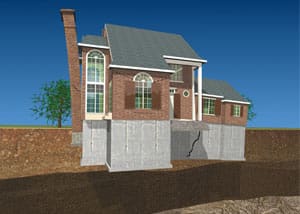
Foundation settlement and house movement can occur when a soil layer can't support the weight of the home.
Identifying foundation settlement issues
Signs of foundation sinking or settling in Erie can be very subtle at first -- many homeowners can go months or even years before noticing a crack in their foundation. The long-term damage from foundation settlement, however, is ongoing and will lead to more severe foundation problems.
5 Signs of Foundation Settlement
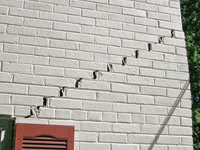
Stair-step cracking is very common in brick and concrete block walls and is a sure sign of foundation settlement. As the settlement house movement continues, vertical cracks may widen or become uneven as wall sections tilt away from each other, indicating more severe displacement.
Keep an eye out for cracks that are wider at the top than at the bottom, as this is a sign of advancing settlement.
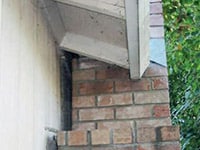
Tilting chimneys that are separating from the home are one of the most intimidating and dramatic signs of a settling foundation.
Sometimes a chimney is built on a footing that is not connected to the house foundation. In this situation, the enormous weight of a chimney can make it even more at risk of settlement.
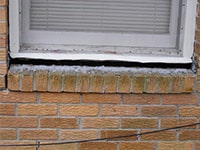
An opening cut in any wall is a weak point, so signs of foundation settlement and house movement often show up around door and window openings.
Doors and windows frames may be racked out of square, cracks may extend from the corners above doors and windows, and doors may separate from the framing or exterior finish. Other signs of foundation settlement include sticking or jamming doors and windows, and locks that stop working.
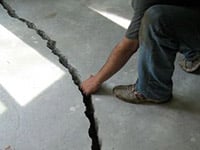
Cracks in your concrete floor slab can be a sign of foundation settlement, but they may also be a sign that the slab floor alone has settled.
There are times when your slab floor may sink or lift independently of the foundation walls, damaging the floors but not necessarily the foundation walls themselves.
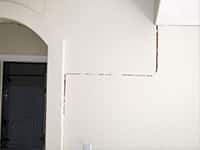
Cracks in drywall throughout the house are reliable indicators of foundation settlement. Cracks will often be larger and more obvious in the home's upper levels.
Typical drywall cracks during foundation settlement are commonly located at the corners of doors and windows and along drywall seams. Drywall tape can also be a good indicator, especially if it's ripping or coming loose. Drywall cracks can also be a sign of sinking crawl space supports, sinking floors, and heaving floors.
Repairing foundation settlement
At Total Foundation Solutions, we recommend installing foundation piers to stabilize, repair, and restore a foundation that's been damaged by issues related to foundation settlement and poor supporting soils.
There are several different types of foundation piers that are designed to address each kind of foundation problem. We install three different kinds of foundation piers: push piers, helical piers, and slab piers to stop your home in the Erie area from sinking.
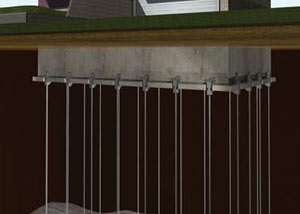
Foundation push piers are straight, steel piers that attach to your foundation and extend far below the structure to strong supporting soils. During the installation, a section of the foundation footing is exposed and cut to attach to each pier's bracket. This is possible year-round from either inside or outside of your foundation or structure.
Foundation brackets are secured to the footing, and tubular pier sections are hydraulically driven through each bracket. Pier sections continue to be driven downwards until the piers meet competent strata that can bear the weight of your home without compression.
When all push piers have been installed, they will work in unison to transfer the weight of the structure to the strong soils or bedrock below. If possible, the home is also lifted back to its original, level position.
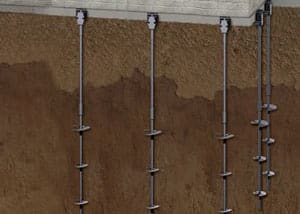
Foundation helical piers are straight, steel piers that have helical blades welded to each shaft. This installation is possible from either inside or outside of your foundation. These piers are driven into the soils underneath your foundation, then each pier is connected to the structure's foundation via a steel bracket.
During the installation, a section of the footing is exposed and cut for each bracket. Next, round-shaft helical piers are mechanically advanced into the soil. Once the helical pier has been advanced into the soil, a foundation bracket is secured to the footing.
When all helical piers have been installed, they will work in unison to transfer the weight of the structure to competent soil. If possible, the structure is also lifted back to a level position.
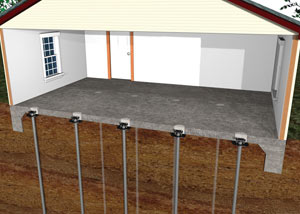
Foundation slab piers are straight steel piers that extend from stable soils deep below the structure to support brackets directly in contact with the underside of the slab. These piers are meant to support a settling concrete floor, and are not appropriate for foundation wall stabilization.
Slab piers are also inappropriate for repairing heaving foundations, where the floor is being lifted by expansive soils or frost heave.
During installation, a small hole is cored through the concrete floor. A slab bracket is assembled beneath the concrete slab, and steel tubes are hydraulically driven down through this bracket assembly.
When the slab piers have reached competent soils, the weight of the slab is transferred through the piers to load-bearing soils below. If possible, the slab is lifted back to level position.
At the end of the installation, grout is pumped under the slab to fill any voids, and all cored holes in the slab are restored with new concrete for a clean, professional look.
We repair settling foundations in PA and NY!
At Total Foundation Solutions, we can identify and repair any issue you may be having with settling, sinking foundations, and settlement house movement. We have a wide variety of solutions for foundation repair that have been tested and proven effective throughout the United States and Canada through the Supportworks network of foundation contractors.
Each of our solutions starts with a free, written foundation repair quote, and includes a personal consultation with a foundation expert, an in-person inspection, and a free copy of our 90-page foundation repair book. To schedule an appointment with one of our specialists, call or e-mail us today! We proudly serve Erie, Edinboro, Warren, Jamestown, Fredonia, Meadville, Du Bois, Harborcreek, Hermitage, Olean, and nearby.
